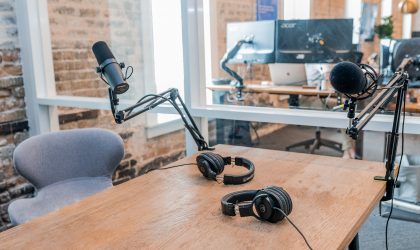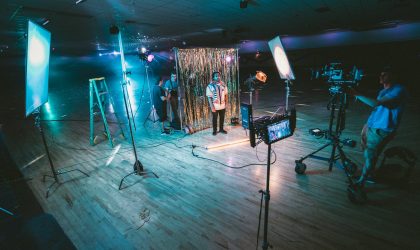Podcasting and how to get started
Why podcasts?
Podcasts offer a good route to reaching audiences who are unable to access your work or venue physically, and at a time and location that is suited to their own commitments.
They can help you build and maintain your relationship with your audience, develop awareness of your work and brand, and help you to communicate your ideas, vision and values.
Podcasts tend to be long form (generally 30-60 minutes in length) and non-visual. In today’s world of video based content and short attention spans, this makes them very different to other online content we consume.
They are sometimes narrative based, as people tend to remember information better if it is given in the form of a story. Podcasts are almost always personal and allow the maker to talk about niche interests. While it may not seem it, you are in effect talking directly to your audience. They have chosen to listen to you. They may even have subscribed to do so. If you are knowledgeable and passionate, even the most esoteric of topics can find an audience.
It is possible to generate revenue from podcasts, but you should not expect it to be a big earner. Podcasting should considered more for the value generated in getting the attention of your audiences, and for sharing your content in a different manner.
Essential building blocks for a successful podcast
Before you run off and record the first thirty episodes of “The History of the Orchestra 1650 – 1850” (or whatever your subject is), there a few things worth thinking about first:
- What is the purpose of your podcast?
- Are you trying to educate an audience?
- Are you trying to raise awareness of your subject?
- Is your idea original or is someone already covering your subject?
- If they are, could you tell it from a different angle or with a different voice or for a different audience?
- What makes your idea or point-of-view unique?
- Do you have at least some expertise on your subject matter?
- Why should people listen to or a value your opinions?
- If you don’t have the knowledge, do you have access to experts who do? And if not, how can you access them?
- Who would make interesting panellists or interviewees?
- Do you have a plan beyond your first episode?
- No-one wants a podcast that runs out of steam after one episode. Good planning is vital to stop that happening.
- It’s recommended that you plan around eight episodes in advance for the duration of your podcast, making sure you know what kind of content you will need and where you will get it from, who you need to talk to and what research you need to do.
- Have you got the right equipment for the kind of podcast you want to make?
- You will need access to sound recording equipment, microphones, and for professional quality you may also want to look into leads, stands, pop filters – all dependent on your budget.
Formats
The kind of podcast you want to create will depend on your content and your audience. You can mix and match, but the advice is to try and stay consistent your audience know what to expect.
| Type |
Description |
Example |
| Interview |
Probably the simplest podcast form. One person speaking to one person at a time. |
Penguin books – interviews with authors |
| Multi-host talk show |
Recommended at the place to start for those with no experience in presenting or interviewing – with this format 2 or more people share the presenting role. |
Kermode & Mayo’s Film review |
| Panel discussion |
A group of experts gathered to discuss a topic usually including a moderator who guides the discussion or asks questions. |
Monocle Culture Show |
| Repurposed |
In this format, content is taken from an existing form, say a radio show or TV and is simply edited to make it suitable for podcasting. |
The Jump |
| Hybrid |
A podcast that is a mixture of the above formats. |
|
| Solo |
Simply one person talking about something they are expert in. |
Hardcore history – Dan Carlin |
| Fiction |
All the above are none-fiction format. Some podcasts are fictional from audio books to audio dramas. |
BBC Radio 4 short stories. |
The equipment
Whilst good sound quality is crucial to your podcast, the good news is that you don’t need expensive, broadcast level equipment to get started.
That said, you do need to have reliable methods of recording and editing audio to get it ready for release online.
Let’s break this down into two areas: Hardware and Software.
Hardware
Often for podcasting you may want to capture content outside a studio, so portable equipment is important. Your choices for this range from using your phone (modern smart phones are surprisingly capable), to choosing a professional field recorder that tests the definition of “portable”.
Somewhere in the middle, an integrated audio recorder is recommended as a good mid-range option. Typical features will include built-in microphones, inputs for additional mics and recording onto memory card for easier transfer to a PC.
Brands such as Tascam and Zoom offer entry level models that are passable, but you get better mics, recording quality, inputs and battery life as you move through the price points.
There are a couple of ways to record phone or skype calls. The simplest is to download an app from your device’s app store. Alternatively, you can use an attachment device or microphone with your phone. And if the person on the opposite end of the call has a similar set up, you could potentially use editing software to make both sides of the call sound like you’re in the same room – unless, of course, you want that ‘phone-voice’ effect.
There are a lot of microphone options to choose from depending on how and what you are trying to capture.
If you are recording more than one person, recording from a distance or want reduce background noise, you might want to consider lavalier or lapel mics, which can be pinned directly to your subject. It helps to have spare mics and have more than one way to capture audio.
In the studio, condenser mics are king – as they offer the best sound quality of all types of microphones. However, their added sensitivity means they require more care and more kit.
Mic stands, pop shields, audio interface, headphones are other equipment you will need to improve sound quality.
If this sounds complicated, then starter packs that contain all the kit you need to get going are available from a couple of hundred pounds and are mail-order. We’ve provided some links to start your research in the ‘Where next?’ section below.
Software
There are two stages to creating a podcast – capturing and editing. You will need software that does one or both functions.
There are a whole host of audio software products on the market. Audacity is an incredibly popular – and free – software that handles capturing and editing well. For something more professional, Adobe Audition is usually the tool of choice – though it uses a subscriber model of £19.97 per month. Website thePodcastHost.com has compiled a handy comparison of both of these software choices.
You might also need music or sound effects. It is strongly recommended that you refrain from using uncleared commercially released music which would require royalty payments unless you have a very strong case for using it. If you do want to use something of that nature, you’ll need to look into licensing options – and quite often this won’t be cheap, so ask yourself how much your podcast really needs it.
Alternatively, there are a multitude of services available online for stock music – both free and paid for. For example, Storyblocks offers tens of thousands of music and sound effects that you can use for a small charge.
Podcast creation checklist
Creating a podcast in 10 easy steps.
- Collect all content
- Rough Edit interviews
- Write script
- Record host over clips
- Insert voiceover clips
- Second, close edit
- Add sound effects
- Add music
- Ensure all volumes are aligned.
- Create one single audio file ready for distribution.
Distribution
To distribute your podcast, you need somewhere to host it.
While you could just host it on your own website (a lot of people do), this may lead to bandwidth issues or incur you extra costs. A better option is to host it on a specialist audio hosting platform.
Libsyn – a specialist podcasting audio host that has packages starting from £5/month, depending on how much space you require and the features you need.
Soundcloud – offers up to 3 hours of content hosting for free, or unlimited hosting for only £10/month.
What’s important is that you need to be able to get a feed from your audio host that you can supply to distribution platforms. This will be straightforward with both above but could be more complex if you used your own website.
You also need to apply and submit your podcast feed to one or more distribution platforms (e.g. Apple Podcasts, Spotify, Acast, Google Podcasts). These are all free and not difficult to submit to. Instructions for a few of the main ones can be found in the above links.
Finally, podcasts need to be marketed like any other product or service. Don’t forget to promote in/on both your online/offline channels – web, social media, email, company literature etc.
Where next?
If you are looking to hear what is possible in the medium – and what’s judged to be the best in the business – take a look at the British Podcast Awards
If you are looking to explore the topics in this article in more detail, Podcast Insights has a wealth of information.
For more on starting a podcast in the cultural sector check out the Space’s guide.
There are also some good tips in this Whole Whale article about podcasting
https://www.wholewhale.com/tips/how-to-make-a-nonprofit-podcast/
For equipment there are a lot of suppliers from entry level to professional, with most offering full kits to get you up and running in no time:
There are many great cultural podcasts available. A few we’d recommend include
- Art Curious – Exploring the unexpected, the slightly odd, and the strangely wonderful in art history.
- Creative Matters – Views from the cutting edge of arts and culture.
- ArtiParti – Celebrating participatory artists and creatives.
- Cultural Peeps – Exploring different Career Pathways across the Museum, Gallery, Heritage and wider Cultural Sectors.
Further Support
The Digital Culture Network is here to support you and your organisation. Our Tech Champions can provide free 1-2-1 support to all arts and cultural organisations who are in receipt of, or eligible for, Arts Council England funding. If you need help or would like to chat with us about any of the advice we have covered above, please get in touch. Sign up to our newsletter below and follow us on Twitter @ace_dcn for the latest updates.








